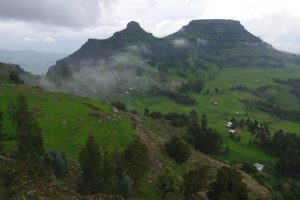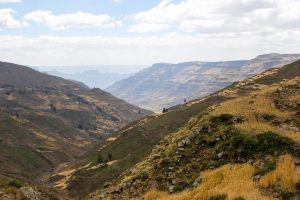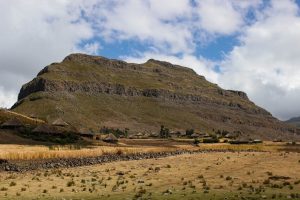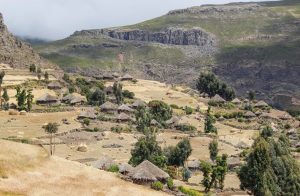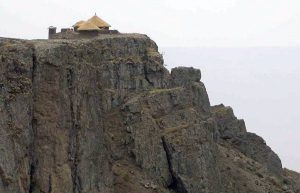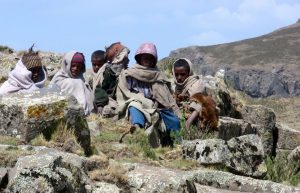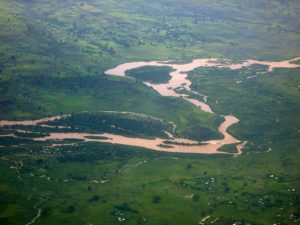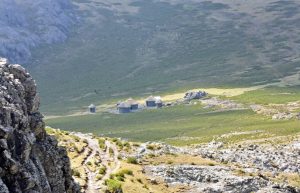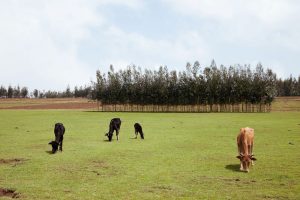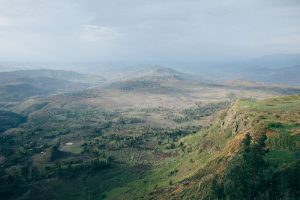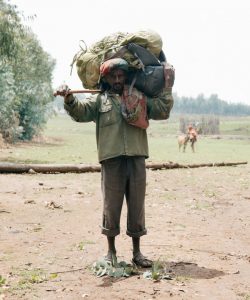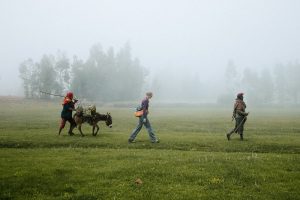The Tefsa village walk, spending three nights in a homestay with local communities. TESFA (Tourism in Ethiopia for Sustainable Future Alternatives) is a wonderful way to escape the tourist circuit and scratch below the surface of Ethiopian life, all the while knowing your money goes directly into the local community. The accommodation is simple, made out of two or three tukuls (cone shaped mud huts) with an eco loo (with a view). The camps are set up on the edge of amazing highlands offering spectacular views.
If harmony and peace of mind are what you are looking for the Tesfa Ethiopian walking tour in Mekete is for you.
For travellers with a sense of adventure, this trekking route along the ridge of the vast, towering Mesket escarpment (to the south of Lalibela) provides a truly unforgettable opportunity to explore Ethiopia’s stunning mountain scenery and meet the people of the rural highlands, whose lives have changed little in many hundreds of years.
The treks, which can last from two days upwards (we recommend a four day trip), are part of an excellent tourism programme run by TESFA (Tourism in Ethiopia for Sustainable Future Alternatives), who work in partnership with small local communities, enabling them to register as private businesses and develop tourism-related ventures, whilst safeguarding their traditions and preserving the local environment.
The MCTW project consists of a number of rustic lodgings in truly spectacular locations, which are dotted along the rim of a plateau running east to west, from Woldiya to Gondar, and are in turn connected by an exciting walking route in an area rarely visited by tourists. There are currently 6 accommodation sites on the route (Mequat Mariam, Wajela, Aterow, Yadukulay, Boya Mikael and Aina Amba), and now that the planned chain all the way to Lalibela is complete, there are 8 community projects, allowing travellers keen on longer treks the option to spend over a week hiking amidst glorious scenery, together with the chance to explore in greater depth the landscapes around Ethiopia’s greatest site of religious pilgrimage.
The Mesket area offers an excellent alternative to the Simien Mountains — being a few thousand feet lower, the climate is a little warmer, gradients are smoother, the walking is fairly easy, and accommodation is vastly superior to camping options in the Simiens. The escarpment itself features a wide variety of plant, bird and animal life as well as caves, rock hewn churches, remote villages and affords stunning views north towards Lalibela and south towards Magdala, even Ras Dashen on a clear day.
Walking the Meket Community Tourism Walk you are unlikely to see many tourists. In fact, when there recently some young children we encountered had never witnessed a non-Ethiopian before, and cried at the sight of us! Except for the odd grind mill and braying donkey, there is no noise pollution and, if it were not for you and your fellow walkers, the scene would appear much like it would have done in the Bible.
At the end of a long day in the sub-tropical heat, rest assured that even though you might be sacrificing some home comforts, overnighting in the tukul (thatched hut) accommodation sites is all part of the experience, made all the more pleasant by the hot shower, home-cooked meal and cold beer which awaits you!
Modest but cosy and welcoming, the sites all boast fantastic views off the escarpment and count three tukuls each, sleeping a maximum of 10 in basic but clean and comfortable beds. (Mequat has one tukul divided into 2 bedrooms sleeping 8 maximum, however they are upgrading by adding an extra tukul which can sleep an additional 3.) There is a separate dining room, shower and eco-toilet all built in the local style. Hot water is hoisted into canvas shower bags on demand each evening. The food prepared by local Ethiopians is hearty and more than adequate. A limited range of drinks are also stocked including beers, colas and bottled water.


